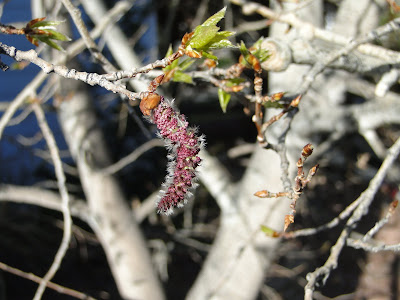
It's good to be home! Spring is busy springing here.

There are a few baby leaves on the trees in our neighborhood, and lots of pollen in the air! We read about catkins in The Bumper Book of Nature by Stephen Moss last night:
"Catkins are remarkable things--clusters of tiny flowers, either sticking up like a furry berry (pussy willow) or hanging down like a rather droopy-looking caterpillar (alder and birch.)"
We don't have pussy willows here, but we still have lots of trees that make catkins.

"Unlike other flowers, catkins don't have large, brightly colored petals because they have no need to attract insects to spread their pollen. Instead, they rely on one of the oldest and reliable forces of nature--the wind."
Super said, "Oh, yeah, those are the things that make me sneeze every spring!"

We read Ugly, by Donna Jo Napoli, on our road trip, and it inspired us to do a bit of bird research. So we read a couple of chapters in Secrets of the Nest by Joan Dunning. It's a fascinating study of how birds have survived by adapting the design of their nests to various habitats and protecting their eggs from various predators.
In the first chapter, Dunning reminds the reader that a) eggs are fragile, b) eggs roll, and c) birds do not have hands! Then she poses this question: "How can I keep my eggs safe?"
I gave the kids a couple of pretend eggs and challenged them to build a nest. (They were allowed to use their hands!) We talked about how different nests are suited to different environments, and the advantages and disadvantages of the various types of nests.
In the first chapter, Dunning reminds the reader that a) eggs are fragile, b) eggs roll, and c) birds do not have hands! Then she poses this question: "How can I keep my eggs safe?"
I gave the kids a couple of pretend eggs and challenged them to build a nest. (They were allowed to use their hands!) We talked about how different nests are suited to different environments, and the advantages and disadvantages of the various types of nests.
They took the challenge very seriously! They came up with all kinds of ways to protect their eggs.
Dude decided he was a kildeer mother, so he made a scrape nest on the ground (living room floor.) After the dogs got too close to his egg, he rethought that idea and decided that his egg needed more protection. He swaddled the egg in so many blankets that I had to remind him that eggs do need air!
Eventually he changed his mind and decided that his egg contained a baby chickadee--the kildeer's ground nest just seemed too vulnerable.
Eventually he changed his mind and decided that his egg contained a baby chickadee--the kildeer's ground nest just seemed too vulnerable.
Super decided to be a tree swallow. She made a cup nest by stuffing a towel between the couch cushions. Tree swallows really like nesting boxes, too. They tend to insulate their eggs with feathers. We didn't have fluffy feathers handy, so tissues provided insulation instead.
All the talk about protecting eggs makes me (almost) feel guilty about enjoying our home-grown eggs so much! We brought home 18 and after 2 days we only have 9 left! This morning I made cheese omelets and apricot jam omelets.

Thanks for sharing, ladies!
All the talk about protecting eggs makes me (almost) feel guilty about enjoying our home-grown eggs so much! We brought home 18 and after 2 days we only have 9 left! This morning I made cheese omelets and apricot jam omelets.

Thanks for sharing, ladies!
2 comments:
We were looking at pussy willows and catkins yesterday! We didn't find any female catkins though, just long male ones. Neat bird photos! I'm finding it hard to get good shots of our birds...I have to shoot through a window. Thanks for stopping by my blog - 14 more days to chicks (hopefully)!
Jessy
Hi, Jessy! I know what you mean--my bird photos tend to catch the second after the bird flew away! I can't take credit for these bird photos--they came from wikimedia commons.
We can't wait to see your chicks--good luck!
Post a Comment